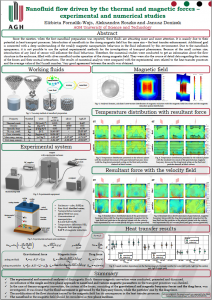2019
XII International Conference on Computational Heat, Mass and Momentum Transfer, 3-6 wrzesień 2019, Rzym, Włochy;
Nanofluid flow driven by the thermal and magnetic forces – experimental and numerical studies
Since the nineties, when the first nanofluid  preparation was reported, these fluids are attracting more and more attention. It is mainly due to their potential in heat transport processes. Introduction of nanofluids in the strong magnetic field has the same aim – the heat transfer enhancement. Additional goal is connected with a deep understanding of the weakly magnetic nanoparticles behaviour in the fluid influenced by this environment. Because of the nanofluids opaqueness, it is not possible to use the optical experimental methods for the investigations of transport phenomena. Therefore, the spectral and Fast Fourier Transform (FFT) analyses were conducted to get the information about flow structure occurring in the enclosure, filled with silver nanofluid under operation of the strong magnetic field. At the same time, the numerical studies were performed as the complementary ones and the source of detail data. Very good agreement between the results was found.
preparation was reported, these fluids are attracting more and more attention. It is mainly due to their potential in heat transport processes. Introduction of nanofluids in the strong magnetic field has the same aim – the heat transfer enhancement. Additional goal is connected with a deep understanding of the weakly magnetic nanoparticles behaviour in the fluid influenced by this environment. Because of the nanofluids opaqueness, it is not possible to use the optical experimental methods for the investigations of transport phenomena. Therefore, the spectral and Fast Fourier Transform (FFT) analyses were conducted to get the information about flow structure occurring in the enclosure, filled with silver nanofluid under operation of the strong magnetic field. At the same time, the numerical studies were performed as the complementary ones and the source of detail data. Very good agreement between the results was found.
32ND International Conference on Efficiency, Cost, Optimization, Simulation and Environmental Impact of Energy Systems, 23-28 czerwiec 2019, Wrocław, Polska
On a role of the nanoparticles in the diamagnetic nanofluid thermo-magnetic convection
Nanofluids in the energy  engineering are considered as the energy carriers. The concept of improving the common fluids thermo-physical properties by addition of the particles is not new. However, its realization was possible due to the technical progress. Numerous publications on the various fluids properties and heat transfer enhancement or its lack can be found. The aim of presented research was to combine two methods of heat transfer improvement, namely the better fluid properties and the additional force. It formed the analyzed system consisted of the nanofluid submitted to the strong magnetic environment. The working fluids were distilled water (as a reference case) and the nanofluids which include distilled water and the silver nanoparticles. It should be mentioned that both of the nanofluid components had negative magnetic susceptibility (they were diamagnetic). The experimental and numerical analyses were carried out and they concentrated on the single and two-phase approaches to the nanofluids and studied phenomena. Besides the heat and mass transfers, the force system dynamics was under consideration with special attention placed on the forces acting on the particles and the fluid and their interaction, which had influence on the overall heat transfer phenomenon. Very good agreement between the experimental and numerical results was obtained.
engineering are considered as the energy carriers. The concept of improving the common fluids thermo-physical properties by addition of the particles is not new. However, its realization was possible due to the technical progress. Numerous publications on the various fluids properties and heat transfer enhancement or its lack can be found. The aim of presented research was to combine two methods of heat transfer improvement, namely the better fluid properties and the additional force. It formed the analyzed system consisted of the nanofluid submitted to the strong magnetic environment. The working fluids were distilled water (as a reference case) and the nanofluids which include distilled water and the silver nanoparticles. It should be mentioned that both of the nanofluid components had negative magnetic susceptibility (they were diamagnetic). The experimental and numerical analyses were carried out and they concentrated on the single and two-phase approaches to the nanofluids and studied phenomena. Besides the heat and mass transfers, the force system dynamics was under consideration with special attention placed on the forces acting on the particles and the fluid and their interaction, which had influence on the overall heat transfer phenomenon. Very good agreement between the experimental and numerical results was obtained.
2018
XI International Conference on Computational Heat, Mass and Momentum Transfer, 21-24 maj 2018, Kraków, Polska;
Comparison of the experimental and numerical analyses of silver nanofluid under influence of strong magnetic field
Nanofluids’ properties made them  interesting for various areas like engineering, medicine or cosmetology. In regard to them, theory considers contribution of particular phases resulting from their amount. In such approach, nanofluid is treated as single-phase. Discussed here research, pertaines to specific problem of heat transfer enhancement with application of the magnetic field. The main idea was to transfer high heat rates with utilization of nanofluids including metallic non-ferrous particles. The expectation was based on changed nanofluid properties. However the results of experimental analysis didn’t meet it. The heat transfer effect was smaller than in the case of base fluid [1]. The only way to understand the process was to involve the computational fluid dynamics, which could help to clarify this issue. In presented experimental and numerical studies two fluids were considered: water and nanofluid. The nanofluid consisted of distilled water and silver nanoparticles of 50 nm diameter (in volume fraction of 0.25%). A two-phase numerical model of ‘nanofluid’ convection based on the Euler-Euler description of two fluid flows dynamics, where the water was recognized as the base fluid and silver nanoparticles as the continuous dispersed phase. The momentum transfer equations for individual phases were coupled through the interphase momentum transfer term expressing the volume force exerted by one phase on the second one. Therefore, the results of numerical simulation predicted decrease of convection heat transfer for nanofluid with respect to pure water (Fig.1), which agreed with the experimental results. On the other hand, the simulation of nanofluid thermomagnetic convection as a single phase mixture, predicted the enhacement of heat transfer. The experimental and numerical results, are in good agreement with each other, what confirms the right choice of two-phase approach in analysis of nanofluid themo-magnetic convection.
interesting for various areas like engineering, medicine or cosmetology. In regard to them, theory considers contribution of particular phases resulting from their amount. In such approach, nanofluid is treated as single-phase. Discussed here research, pertaines to specific problem of heat transfer enhancement with application of the magnetic field. The main idea was to transfer high heat rates with utilization of nanofluids including metallic non-ferrous particles. The expectation was based on changed nanofluid properties. However the results of experimental analysis didn’t meet it. The heat transfer effect was smaller than in the case of base fluid [1]. The only way to understand the process was to involve the computational fluid dynamics, which could help to clarify this issue. In presented experimental and numerical studies two fluids were considered: water and nanofluid. The nanofluid consisted of distilled water and silver nanoparticles of 50 nm diameter (in volume fraction of 0.25%). A two-phase numerical model of ‘nanofluid’ convection based on the Euler-Euler description of two fluid flows dynamics, where the water was recognized as the base fluid and silver nanoparticles as the continuous dispersed phase. The momentum transfer equations for individual phases were coupled through the interphase momentum transfer term expressing the volume force exerted by one phase on the second one. Therefore, the results of numerical simulation predicted decrease of convection heat transfer for nanofluid with respect to pure water (Fig.1), which agreed with the experimental results. On the other hand, the simulation of nanofluid thermomagnetic convection as a single phase mixture, predicted the enhacement of heat transfer. The experimental and numerical results, are in good agreement with each other, what confirms the right choice of two-phase approach in analysis of nanofluid themo-magnetic convection.
XXIII Fluid Mechanics Conference, 9-12 wrzesień 2018, Zawiercie, Polska
Nanofluid in the magnetic field one- or two-phase approach
Nanofluids are group of fluids commonly studied in  various engineering areas. In each field the advantages and drawbacks of their applications are equally numerous. The theory on nanofluids regards them as one-phase fluids possessing the properties defined by both phases. This kind of approach is typical in the experimental analysis, but it should be mentioned that measured nanofluid properties very often differ from the theoretical ones. In the computational fluid dynamics the nanofluids can be implemented as one- or two-phase fluids, but still the one-phase case is the most common. In this paper discussion on treatment of nanofluid under an influence of magnetic field is presented. It was initiated by the analysis of experimental data of CuO and AgO nanofluids placed in the strong magnetic field. It was found that one-phase approach did not explain the mass and heat transfer processes in the investigated system.
various engineering areas. In each field the advantages and drawbacks of their applications are equally numerous. The theory on nanofluids regards them as one-phase fluids possessing the properties defined by both phases. This kind of approach is typical in the experimental analysis, but it should be mentioned that measured nanofluid properties very often differ from the theoretical ones. In the computational fluid dynamics the nanofluids can be implemented as one- or two-phase fluids, but still the one-phase case is the most common. In this paper discussion on treatment of nanofluid under an influence of magnetic field is presented. It was initiated by the analysis of experimental data of CuO and AgO nanofluids placed in the strong magnetic field. It was found that one-phase approach did not explain the mass and heat transfer processes in the investigated system.
